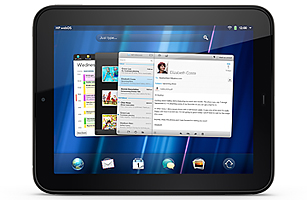
When Apple unveiled the iPad in January of 2010, it left a gaggle of other consumer-electronics companies suddenly anxious to get into the tablet game. Very, very anxious. So anxious, in fact, that some of them set deadlines for themselves that made it impossible to ship fully-baked products.
That was certainly true of Samsung’s original Galaxy Tab, which ran an operating system designed for phones, not tablets. And Motorola’s Xoom, which debuted without several of its key features and with a buggy version of Google’s Android Honeycomb operating system. And RIM’s BlackBerry PlayBook, which was just a mess.
HP, however, came off as less frantic than its peers. True, it plunked down $1.2 billion a year ago to buy mobile-computing pioneer Palm and its excellent WebOS operating system. But then it announced that its first WebOS tablet, the TouchPad, wouldn’t be ready until this summer. It’s an important product — the flagship of an entire fleet of WebOS gizmos that HP says is on its way, including phones, printers, PCs, additional tablets, and maybe even products manufactured by other companies.
Wait for the TouchPad until HP could release something that felt refined, not rushed? That didn’t feel like an imposition — it sounded like a great idea.
The tablet starts shipping this Friday. For the past week, I’ve lived with one that HP loaned to me. And while I found lots to like, I also discovered that the extra time that the company took hasn’t paid off in a perfectly polished product. Actually, the TouchPad I’ve been using is downright buggy, and suffers from a shortage of key apps. Which is why my advice to anyone who wants to buy a tablet right now remains unchanged: Get an iPad 2.
That recommendation isn’t set in stone. The TouchPad that early-paying customers receive will be at least slightly better than the one I tested: HP says that several notable apps which I couldn’t try will arrive at the very last minute. The company is already working on a software update intended to make the tablet more spritely and less quirky, and reports that useful features such as the ability to edit word-processing documents and spreadsheets will be along soon.
HP may have visions of a bevy of WebOS devices dancing in its head, but it’s starting with a single tablet that doesn’t try particularly hard to be unlike the iPad. Even the pricing is the same: $499 for a 16GB wi-fi model and $599 for a 32GB one.
Most companies that build iPad rivals get creative with the display — it’s bigger or smaller than Apple’s, and usually has a wider aspect ratio designed with movies in mind. HP didn’t mess with a good thing: the TouchPad sports a magazine-like 9.7″ screen with 1024-by-768 resolution, just like the iPad. It’s one of the most pleasing tablet displays I’ve seen to date, even though it appears to default to a dimmer brightness setting than the iPad 2, perhaps to conserve battery power.